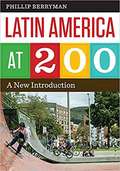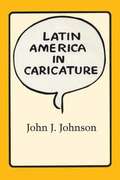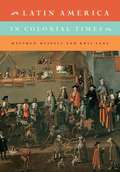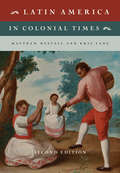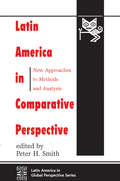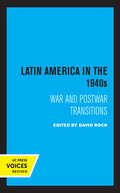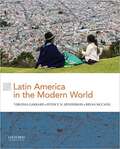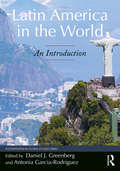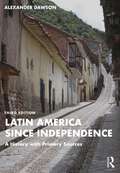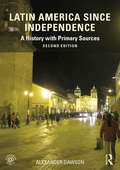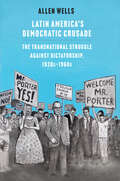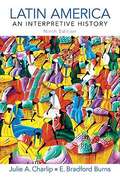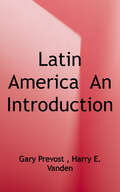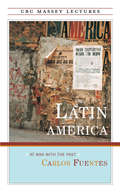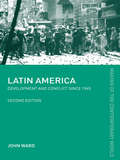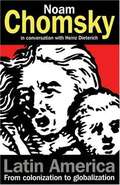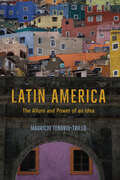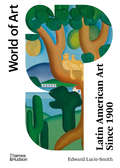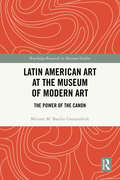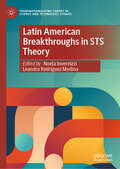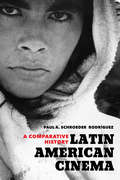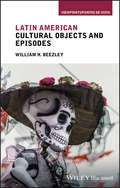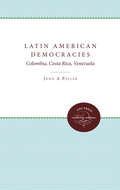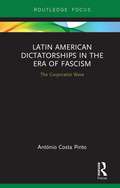- Table View
- List View
Latin America at 200: A New Introduction (Joe R. And Teresa Lozano Long Series In Latin American And Latino Art And Culture)
by Phillip BerrymanBetween 2010 and 2025, most of the countries of Latin America will commemorate two centuries of independence, and Latin Americans have much to celebrate at this milestone. Most countries have enjoyed periods of sustained growth, while inequality is showing modest declines and the middle class is expanding. Dictatorships have been left behind, and all major political actors seem to have accepted the democratic process and the rule of law. Latin Americans have entered the digital world, routinely using the Internet and social media. <P><P>These new realities in Latin America call for a new introduction to its history and culture, which Latin America at 200 amply provides. Taking a reader-friendly approach that focuses on the big picture and uses concrete examples, Phillip Berryman highlights what Latin Americans are doing to overcome extreme poverty and underdevelopment. He starts with issues facing cities, then considers agriculture and farming, business, the environment, inequality and class, race and ethnicity, gender, and religion. His survey of Latin American history leads into current issues in economics, politics and governance, and globalization. Berryman also acknowledges the ongoing challenges facing Latin Americans, especially crime and corruption, and the efforts being made to combat them. Based on decades of experience, research, and travel, as well as recent studies from the World Bank and other agencies, Latin America at 200 will be essential both as a classroom text and as an introduction for general readers.
Latin America in Caricature
by John J. Johnson"Not many readers will thank the author as he deserves, for he has told us more about ourselves than we perhaps wish to know," predicted Latin America in Books of Latin America in Caricature-an exploration of more than one hundred years of hemispheric relations through political cartoons collected from leading U. S. periodicals from the 1860s through 1980. The cartoons are grouped according to recurring themes in diplomacy and complementing visual imagery. Each one is accompanied by a lengthy explanation of the incident portrayed, relating the drawing to public opinion of the day. Johnson's thoughtful introduction and the comments that precede the individual chapters provide essential background for understanding U. S. attitudes and policies toward Latin America.
Latin America in Colonial Times
by Matthew Restall Kris LaneFew milestones in human history are as dramatic and momentous as the meeting of three great civilizations on American soil in the sixteenth century. Latin America in Colonial Times presents that story in an engaging but scholarly new package, revealing how a new civilization - Latin America - emerged from that encounter. The authors give equal attention to the Spanish and Portuguese conquerors and settlers, to the African slaves they brought across the Atlantic, and to the indigenous peoples whose lands were invaded. From the dawn of empires in the fifteenth century, through the conquest age of the sixteenth, to the end of empire in the nineteenth, Latin America in Colonial Times combines broad brush strokes with the anecdotal details that bring the era to life.
Latin America in Colonial Times
by Matthew Restall Kris LaneFew milestones in human history are as dramatic and momentous as the meeting of three great civilizations on American soil in the sixteenth century. Latin America in Colonial Times presents that story in an engaging but scholarly new package, revealing how a new civilization - Latin America - emerged from that encounter. The authors give equal attention to the Spanish and Portuguese conquerors and settlers, to the African slaves they brought across the Atlantic, and to the indigenous peoples whose lands were invaded. From the dawn of empires in the fifteenth century, through the conquest age of the sixteenth, to the end of empire in the nineteenth, Latin America in Colonial Times combines broad brush strokes with the anecdotal details that bring the era to life.
Latin America in Colonial Times
by Matthew Restall Kris LaneFew milestones in human history are as momentous as the meeting of three great civilizations on American soil in the sixteenth century. The fully revised textbook Latin America in Colonial Times presents that story in an engaging but informative new package, revealing how a new civilization and region - Latin America - emerged from that encounter. The authors give equal attention to the Spanish and Portuguese conquerors and settlers, to the African slaves they brought across the Atlantic, and to the indigenous peoples whose lands were invaded. From the dawn of empires in the fifteenth century, through the conquest age of the sixteenth and to the end of empire in the nineteenth, the book combines broad brushstrokes with anecdotal details that bring the era to life. This new edition incorporates the newest scholarship on Spain, Portugal, and Atlantic Africa, in addition to Latin America itself, with indigenous and African views and women's experiences and contributions to colonial society highlighted throughout.
Latin America in Comparative Perspective: New Approaches to Methods and Analysis (Latin America in Global Perspective)
by Peter H Smith<p>This book, the inaugural publication in a multivolume series entitled Latin America in Global Perspective, highlights the necessity and feasibility of analyzing Latin American society and politics within broad comparative frameworks. <p>The rapidly changing agenda for social science research on the region calls for the rigorous application of new concepts and methodologies, especially in light of the apparent exhaustion of the “dependency” paradigm. The examination of broad themes, such as development strategies and processes of democratization, can be facilitated through systematic comparisons with other world regions, and the study of specific issues—such as electoral behavior or social inequality—requires the judicious use of quantitative measurement. The question, therefore, is not only what to investigate but also how. <p>This volume brings together original research by distinguished scholars from a variety of countries. Analytical chapters explore methodological strategies for cross-regional comparison, intraregional comparison, and the application of rational choice; topical chapters offer new approaches to the study of women, state power, corporatism, and political culture. A concluding section examines the political significance of public opinion research in Mexico, Peru, and the former Soviet Union.</p>
Latin America in the 1940s: War and Postwar Transitions
by David RockThis title is part of UC Press's Voices Revived program, which commemorates University of California Press’s mission to seek out and cultivate the brightest minds and give them voice, reach, and impact. Drawing on a backlist dating to 1893, Voices Revived makes high-quality, peer-reviewed scholarship accessible once again using print-on-demand technology. This title was originally published in 1994.
Latin America in the Modern World
by Peter V. N. Henderson Bryan McCann Virginia GarrardLatin America in the Modern World is the first text to situate the history of Latin America within a wider global narrative. Written by leading scholars, the book focuses on five themes: state formation; the construction of national identity through popular culture and religion; economics and commodities; race, class, and gender; and the environment. Emphasizing the distinct experiences of each of the Latin American countries, the book provides students with an entry point into understanding this vital region. Instead of suggesting that all Latin American nations have an interchangeable heritage, the authors seek to clearly identify themes, topics, people, and intellectual currents that help to knit the history of modern Latin America into a coherent category of study. While providing in-depth coverage of the history of the three largest Latin American countries (Mexico, Brazil, and Argentina), Latin America in the Modern World also offers case studies from almost all of the countries, including Central American and Andean nations.
Latin America in the World: An Introduction (Foundations in Global Studies)
by Antonia Garcia-Rodriguez Daniel J. GreenbergFrom the Foundations in Global Studies series, this text offers students a fresh, comprehensive, multidisciplinary entry point to Latin America. After a brief introduction to the study of the region, the early chapters of the book survey the essentials of Latin American history; important historical narratives; and the region’s languages, religions, and global connections. Students are guided through the material with relevant maps, resource boxes, and text boxes that support and guide further independent exploration of the topics at hand. The second half of the book features interdisciplinary case studies, each of which focuses on a specific country or subregion and a particular issue. Each chapter gives a flavor for the cultural distinctiveness of the particular country yet also draws attention to global linkages. Readers will come away from this book with an understanding of the larger historical, political, and cultural frameworks that shaped Latin America as we know it today, and of current issues that have relevance in Latin America and beyond.
Latin America since Independence: A History with Primary Sources
by Alexander DawsonNow in its third edition, Latin America since Independence explores the region’s rich and diverse history through carefully selected stories, primary source documents, maps, and tables that offer a diverse approach to dominant historical narratives. While histories of the "other" Americas often link disparate histories through revolutionary or tragic narratives, this text begins with the assumption that our efforts to imagine a common past for nearly thirty countries are deeply problematic. Without losing sight of chronology or regional trends, the book offers a distinctive conceptualization of the region as a diverse social landscape with a multiplicity of peoples and voices. Each chapter introduces students to a specific historical issue, which in turn raises questions about the history of the Americas as a whole. Key themes include: Race and Citizenship Inequality and Economic Development Politics and Rights Foreign Interventions Social and Cultural Movements Globalization Violence and Civil Society The Environment Chapters also include timelines highlighting important dates and suggestions for further reading. This third edition has been updated throughout and includes a new Chapter 9 that discusses foreign intervention in Central America, and new text on the drug wars, resource extraction, and indigenous self-determination. Richly informative and highly readable, Latin America since Independence provides compelling accounts of this region’s past and present that will be of interest to students of Latin American history and society.
Latin America since Independence: A History with Primary Sources
by Alexander DawsonWhat is Latin America, after all? While histories of the "other" Americas often link disparate histories through revolutionary or tragic narratives, Latin America since Independence begins with the assumption that our efforts to imagine a common past for nearly thirty countries are deeply problematic. Without losing sight of chronology or regional trends, this text offers glimpses of the Latin American past through carefully selected stories. Each chapter introduces students to a specific historical issue, which in turn raises questions about the history of the Americas as a whole. Key themes include: Race and Citizenship Inequality and Economic Development Politics and Rights Social and Cultural Movements Globalization Violence and Civil Society The short, thematic chapters are bolstered by the inclusion of relevant primary documents - many translated for the first time - including advertisements and posters, song lyrics, political speeches, government documents, and more. Each chapter also includes timelines highlighting important dates and suggestions for further reading. Richly informative and highly readable, Latin America since Independence provides compelling accounts of this region's past and present. This second edition brings the story up to the present, with revised chapters, new primary documents and images, and a new 'At A Glance' feature that uses a selection of maps and tables to illuminate key issues like the economy, the environment, and demographics. For additional information and classroom resources please visit the Latin America since Independence companion website at www.routledge.com/cw/dawson.
Latin America's Democratic Crusade: The Transnational Struggle against Dictatorship, 1920s-1960s
by Allen WellsBy emphasizing Latin American reformers’ decades-long struggle to defeat authoritarianism, this transnational history challenges the timeworn Cold War paradigm and recasts the region’s political evolution Scholars persist in framing the Cold War as a battle between left and right, one in which the Global South is cast as either witting or unwitting proxies of Washington and Moscow. What if the era is told from the perspective of the many who preferred reform to revolution? Scholars have routinely neglected, dismissed, or caricatured moderate politicians. In this book, Allen Wells argues that until the Cuban Revolution, the struggle was not between capitalism and communism—that was Washington’s abiding preoccupation—but between democracy and dictatorship. Beginning in the 1920s, the fight against authoritarianism was contested on multiple fronts—political, ideological, and cultural—taking on the dimensions of a political crusade. Convinced that despots represented an existential threat, reformers declared that no civilian government was safe until the cancer of dictatorship was excised from the hemisphere. Dictators retaliated, often with deadly results, exporting strategies that had been honed at home to guarantee their political survival. Grafted onto this war without borders was a belated Cold War, with all its political convulsions, the aftershocks of which are still felt today.
Latin America: An Interpretive History (Ninth Edition)
by Julie A. Charlip E. Bradford BurnsFor courses in the History of Latin America and Modern Latin America. Organized thematically, this text offers a clear narrative that weaves the story of Latin America together with coverage of broader themes and regional differences. In addition to the great diversity within Latin America, there is also a common theme that encompasses the sweep of history in the region. The original author of the text, E. Bradford Burns, cast the problem as the paradox that poor people inhabit rich lands. The reason for this paradox is that a tiny group of elites confuses their nation's well-being with their own. When this text was first published in 1972, there were very few texts on Latin America, and the ones that existed largely read like catalogs of historical events. Although there are others now, this textbook is still a leader in the field because of its clear thematic organization and a central narrative that tells a cohesive story, albeit with many variations. Co-author Julie A. Charlip is committed to continuing the Burns legacy. Despite changes in research, interpretations, and theories, Burns's basic premise is still the most accurate and succinct, providing the best framework for approaching the region.
Latin America: An Introduction
by Harry E. Vanden Gary PrevostThis book offers a contemporary, thematic analysis of the region that is grounded in Latin America's social, political, economic, and cultural past. <p><p>Based on chapters from Harry Vanden and Gary Prevost's popular text, Politics of Latin America, this book provides an accessible and interesting discussion of a broad range of topics, including democracy, revolution, indigenous populations, culture, gender, religion, politics, economy, and relations with the United States. Unlike many texts on the region, this book places the voices of long-ignored and previously marginalized groups in Latin America--women, indigenous peoples, Afro-Latinos, workers, peasants, and gays and lesbians--at the heart of its analysis. Offering balanced regional coverage, the book discusses such recent political, social, and economic developments as the failure of the neoliberal economic policies of the 1980s and 1990s to deliver promised prosperity; the related resurgence of progressive politics in the region, as manifested in the election of numerous left and center-left governments; and the strong role of numerous social movements in setting the region's political agenda in the new century. <p><p>The authors analyze the continuing power of the United States in the region, as seen in the implementation of the Central America Free Trade Agreement (CAFTA), bilateral trade agreements with Chile and Peru, and the continued funding of Plan Colombia. They also discuss the role of various Latin American-based initiatives, including the expansion of MERCOSUR, the Bolivarian Alternative, and The Bank of the South. Providing a historical perspective for the challenges and problems facing the region today, Latin America: An Introduction's regionally balanced, multidisciplinary approach makes it an ideal text for introduction to Latin American studies courses.
Latin America: At War with the Past (The CBC Massey Lectures)
by Carlos FuentesA passionate argument for the geopolitical autonomy of Latin America, Carlos Fuentes's 1984 CBC Massey lectures trace the region's unique historical and cultural tensions and call upon foreign powers to cease interference in a sphere of influence they rarely fully understand. Fuentes sees the turbulence in Latin America ending not with political solutions, but economic ones. Foreshadowing the end of the Cold War, the signing and expansion of NAFTA, and the Mexican peso crisis of 1994, Fuentes urges further co-development in a progressively interdependent world and the creation of a new global economic and financial system. The new world economic order is not an exercise in philanthropy, he contends, but in enlightened self-interest for everyone concerned. Forthright and intelligently reasoned, Carlos Fuentes's Latin America is a timeless book about the challenges facing emergent democracies and the opportunities for growth that exist within the countries themselves.
Latin America: Development and Conflict since 1945 (The Making of the Contemporary World)
by John WardBringing the story up-to-date, this expanded new edition takes into account recent developments including Argentina's 2001 debt default and the 2002 presidential election in Brazil. Latin America provides an introduction to the economic and political history of the region in the last half century. Beginning with a brief history of Latin America since 1492, John Ward discusses the interactions between economic, political and social issues. The discussions includes: * the long-term background to the 1980s debt crisis* the effects of neo-liberal free market reforms* relations with the United States and the wider world* welfare provision in relation to wider economic issues* social trends as reflected by changes in the status of women* globalization and environmental debates* comparisons with the more dynamic East Asian economies. Also including biographies of the leading figures of the period and an expanded bibliography, it will provide central reading to Latin American history students, researchers and the interested general reader.
Latin America: From Colonization to Globalization
by Noam Chomsky Heinz DieterichIn conversation with Heinz Dieterich, acclaimed political commentator Chomsky reviews a continent on the brink of a major economic and political crisis. An indispensable book for those interested in Latin America and the politics and history of the region.
Latin America: The Allure and Power of an Idea
by Mauricio Tenorio-Trillo“Latin America” is a concept firmly entrenched in its philosophical, moral, and historical meanings. And yet, Mauricio Tenorio-Trillo argues in this landmark book, it is an obsolescent racial-cultural idea that ought to have vanished long ago with the banishment of racial theory. Latin America: The Allure and Power of an Idea makes this case persuasively. Tenorio-Trillo builds the book on three interlocking steps: first, an intellectual history of the concept of Latin America in its natural historical habitat—mid-nineteenth-century redefinitions of empire and the cultural, political, and economic intellectualism; second, a serious and uncompromising critique of the current “Latin Americanism”—which circulates in United States–based humanities and social sciences; and, third, accepting that we might actually be stuck with “Latin America,” Tenorio-Trillo charts a path forward for the writing and teaching of Latin American history. Accessible and forceful, rich in historical research and specificity, the book offers a distinctive, conceptual history of Latin America and its many connections and intersections of political and intellectual significance. Tenorio-Trillo’s book is a masterpiece of interdisciplinary scholarship.
Latin American Art Since 1900 (World of Art #0)
by Edward Lucie-SmithAn extraordinary synthesis of more than a century’s worth of art across Central and South America, Latin American Art Since 1900 covers everyone from popular figures such as Diego Rivera and Frida Kahlo, to a wide range of other artists who are less well-known outside Latin America. In this classic survey, now updated with full-color images throughout, Edward Lucie-Smith introduces the art of Latin America from 1900 to the present day. Lucie-Smith examines major artists such as Diego Rivera and Frida Kahlo, as well as dozens of less familiar Latin American artists and exiled artists from Europe and the United States who spent their lives in South America, such as Leonora Carrington. The author explains the political context for artistic development and sets the works in national, cultural, and international frameworks. Featured in this book are the artists who have searched for indigenous roots and local tradition; explored abstraction, expressionism, and new media; entered into dialogue with European and North American movements, while insisting on reaching a wide, popular audience for their work; and created an energetic, innovative, and varied art scene across the South American continent. With a new chapter that extends the discussion into the twenty-first century, a constant theme of Latin American Art Since 1960 is the embrace of the experimental and the new by artists across Latin America.
Latin American Art at The Museum of Modern Art: The Power of the Canon (Routledge Research in Museum Studies)
by Miriam M. Basilio GaztambideThis book sheds light on an as-yet unstudied aspect of The Museum of Modern Art’s (MoMA) preeminent role in establishing the definition of the problematic term “Latin American art” in the United States from the 1930s to the present through its collection displays. In examining the shifting categorization of Latin American works according to stylistic and geographic taxonomies, we gain a greater understanding of the organization of the Museum’s collections as a whole during the 1940s and 1950s. This book is the first to document these institutional precedents, crucial for the understanding of the articulation of a Modernist canon and its contested legacy today.The MoMA is widely recognized as the preeminent institution that defined 20th-century art through its collection – shaping our understandings of the history of art, with its hierarchies and exclusions, as they sediment over time. MoMA’s holdings of art from Latin America shed light on a key period when the stylistic categories that have since come to be accepted by many today as the Modernist canon developed. MoMA’s collection displays suggest ways in which artists from areas of the world formerly excluded can be incorporated within today’s increasingly global museums. MoMA’s approach may be compared to initiatives adopted by several museums since the 2000s, creating geographically defined curatorial positions as a way to redress gaps in collecting art from Latin America and other areas of the world. In this book, author Miriam M. Basilio Gaztambide offers a closer study of the history of collection displays as a means to understand canon formation in modern art museums.This work will be of interest to those researching Latin American, American, modern, and contemporary art, and curatorial and museum studies.
Latin American Breakthroughs in STS Theory (Transnationalizing Theory in Science and Technology Studies)
by Leandro Rodriguez Medina Noela InvernizziThis book enriches Latin American Science and Technology Studies by making a pioneering contribution to theories from its geopolitical margins. Rather than merely challenging Northern dominance, it fosters dialogue between Northern and Southern scholars, highlighting the complex, multi-situated development of science and technology and contributing to the field&’s diversification and internationalization.
Latin American Cinema
by Paul A. Schroeder RodríguezThis book charts a comparative history of Latin America's national cinemas through ten chapters that cover every major cinematic period in the region: silent cinema, studio cinema, neorealism and art cinema, the New Latin American Cinema, and contemporary cinema. Schroeder Rodríguez weaves close readings of approximately fifty paradigmatic films into a lucid narrative history that is rigorous in its scholarship and framed by a compelling theorization of the multiple discourses of modernity. The result is an essential guide that promises to transform our understanding of the region's cultural history in the last hundred years by highlighting how key players such as the church and the state have affected cinema's unique ability to help shape public discourse and construct modern identities in a region marked by ongoing struggles for social justice and liberation.
Latin American Cultural Objects and Episodes (Viewpoints / Puntos de Vista)
by William H. BeezleyDelight in the cultural aspects of Latin America by observing the objects that give life to history Latin American Cultural Objects and Episodesprovides readers with an eclectic and fascinating exploration of Latin American history through the examination of physical objects. Distinguished author and Professor William H. Beezley takes readers on a journey that includes objects used music and visual media, such as movies, documentaries, and television. Forming an integral part of the history they represent, the objects described in this book tell the tale of the little known or neglected part of Latin American history. While most historical authors and researchers focus on the political and economic life of Latin America, this author uses the objects he highlights to explain and illuminate the daily lives of the Latin American peoples and the legacies that they share. Forming an essential part of a comprehensive understanding of Latin American history, the book includes discussions and explorations of: How objects have transformed and shaped the cultures of Latin America over the years Unusual and interesting objects serendipitously discovered by a variety of researchers and historians Ten chapters, each beginning with an object acting as a synecdoche or metonym that introduces a discussion of Latin American historical life The significance of the objects to particular religious practices, musical traditions, or schools of visual media, such as folk art, film or television Perfect for anyone interested in Latin American life beyond politics and economics, Latin American Cultural Objects and Episodes belongs on the bookshelves of everyone with a curiosity about culture in Latin America as it’s revealed through physical objects.
Latin American Democracies: Colombia, Costa Rica, Venezuela
by John A. PeelerUsing the cases of Columbia, Costa Rica, and Venezuela, Peeler compares the evolution and maintenance of liberal democratic regimes in the Latin American context. These regimes are shown to be products of the normal Latin American political processes, under particular conditions that have permitted accommodation between rival political and economic elites. The author argues that these liberal democracies are fundamentally similar to those in other parts of the world.Originally published in 1985.A UNC Press Enduring Edition -- UNC Press Enduring Editions use the latest in digital technology to make available again books from our distinguished backlist that were previously out of print. These editions are published unaltered from the original, and are presented in affordable paperback formats, bringing readers both historical and cultural value.
Latin American Dictatorships in the Era of Fascism: The Corporatist Wave (Routledge Studies in Fascism and the Far Right)
by António Costa PintoLatin American Dictatorships in the Era of Fascism focuses on the reverse-wave of dictatorships that emerged in Latin America during the 1930s and the transnational dissemination of authoritarian institutions in the era of fascism. António Costa Pinto revisits the study of authoritarian alternatives to liberal democracy in 1930s Latin America from the perspective of the diffusion of corporatism in the world of inter-war dictatorships. The book explores what drove the horizontal spread of corporatism in Latin America, the processes and direction of transnational diffusion, and how social and political corporatism became a central set of new institutions utilized by dictatorships during this era. These issues are studied through a transnational and comparative research design to reveal the extent of Latin America’s participation during the corporatist wave which by 1942 had significantly reduced the number of democratic regimes in the world. This book is essential reading for students studying Latin American history, 1930s dictatorships and authoritarianism, and the spread of corporatism.
